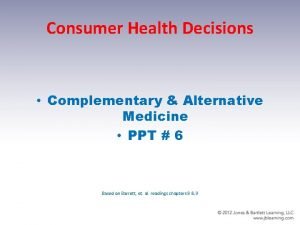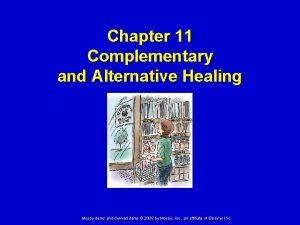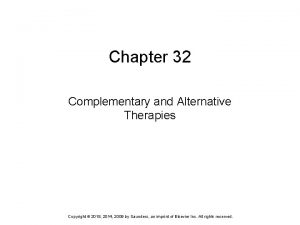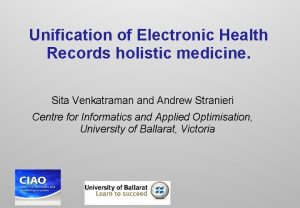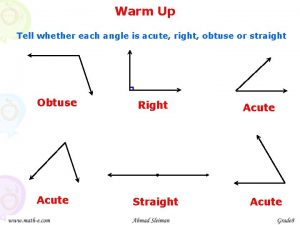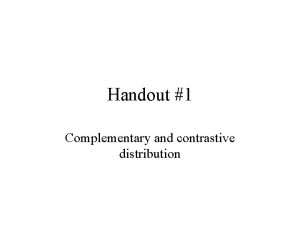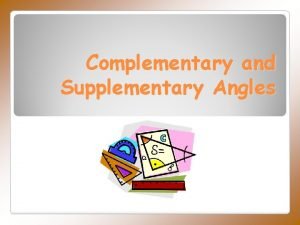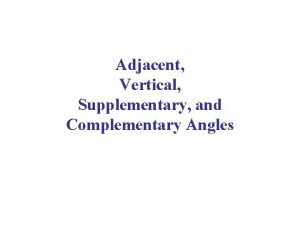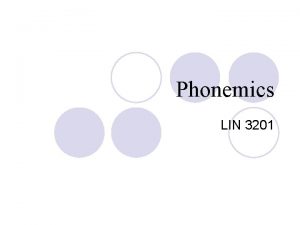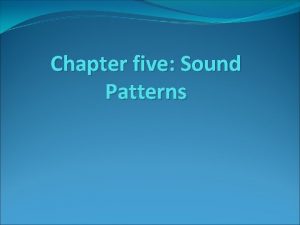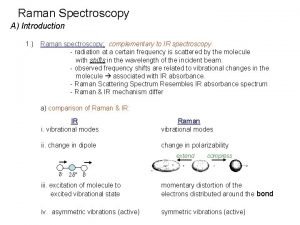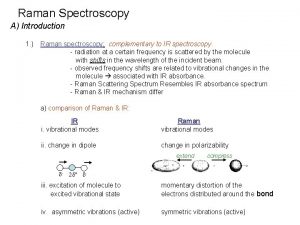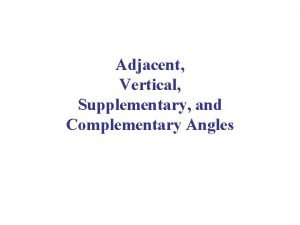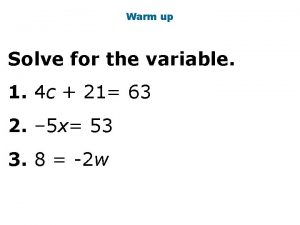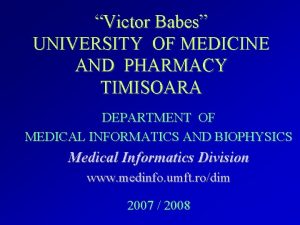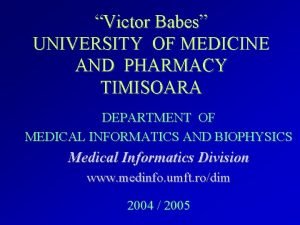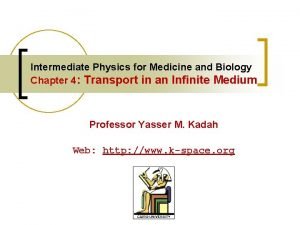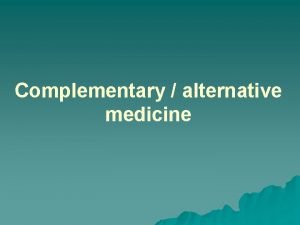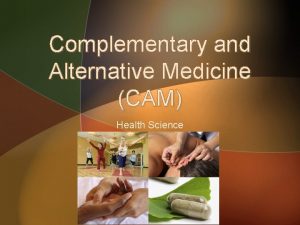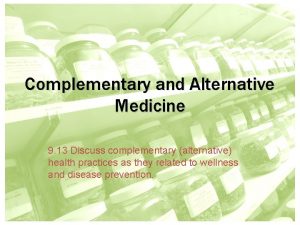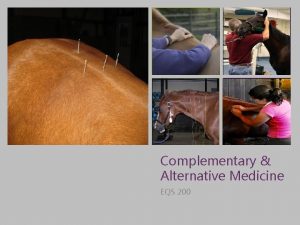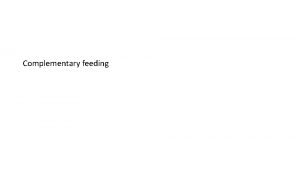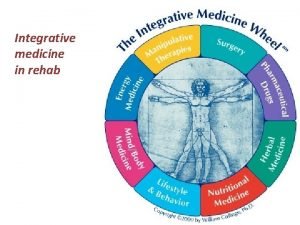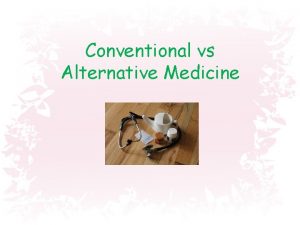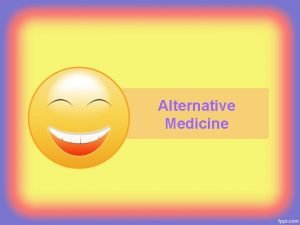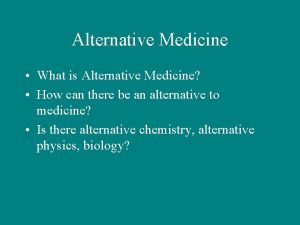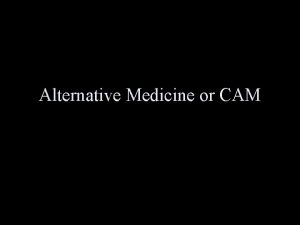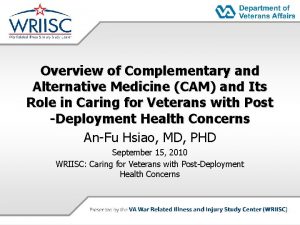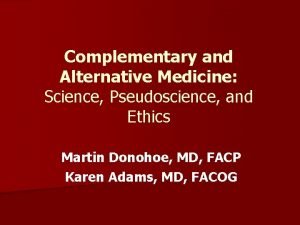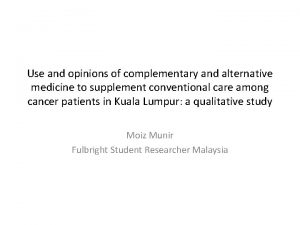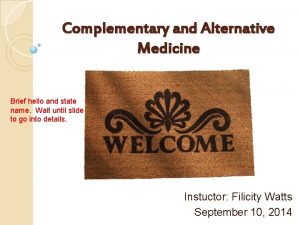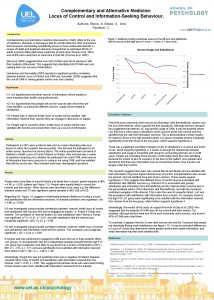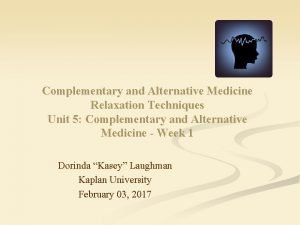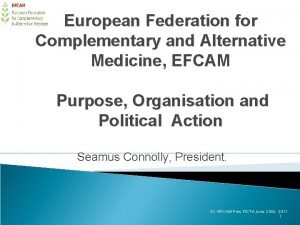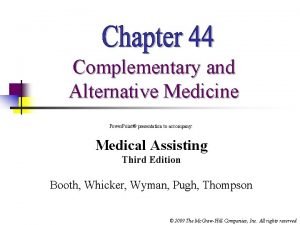Complementary alternative medicine What is complementary and alternative

























- Slides: 25

Complementary / alternative medicine

What is complementary and alternative medicine (CAM)? u It is a group of diverse medical and health care systems, practices and products that are not presently considered to be part of conventional medicine.

Are complementary medicine and alternative medicine different from each other?

Yes, they are different

u Complementary medicine is used together with conventional medicine. An example of a complementary therapy is using aromatherapy to help lessen a patient’s discomfort following surgery. u Alternative medicine is used in place of conventional medicine. An example of an alternative therapy is using a special diet to treat cancer instead of undergoing surgery, radiation, or chemotherapy that has been recommended by a conventional doctor.

What are the major types of complementary and alternative medicine?

NCCAM classifies CAM therapies into five categories, or domains

1. Alternative Medical Systems. e. g. Traditional Chinese Medicine and Ayurveda 2. Mind-Body Interventions. e. g. prayer, meditation, art, music, or dance. 3. Biologically Based Therapies. e. g. dietary supplements & herbal products 4. Manipulative and Body-Based Methods. e. g. chiropractic manipulation & massage 5. Energy Therapies. I. Biofield therapies. e. g. qi gong II. Bioelectromagnetic-based therapies.

Medical Herbalism

u Medical herbalism is the use of plant remedies in the prevention and treatment of illness. u Today, medical herbalism, practiced by medical herbalists, originate from traditional knowledge, but increasingly applied in a modern context.

u 1. 2. One of the tenets of herbalism is that the different constituents of a herb act together in some way that has beneficial effects. These could be: Additive effect: The combined effect of two drugs is equal to the sum of their individual actions. Synergistic effect: The combined effect of two drugs is greater than the sum of the individual effects.

Herbalist’s prescriptions u Generally, a combination of several different herbs (usually 4 -6) is used in the treatment of a particular patient. u sometimes, a single herb may be given. u Each patient’s treatment is reviewed regularly and is likely to be changed depending on whether or not there has been a response.

Comparison of herbalism with rational phytotherapy u 1. 2. 3. 4. 5. 6. Herbalism Assume that synergy or additive effects occur between herbs. Holistic prescribing. Preparations mainly formulated as tinctures. Mainly uses combinations of herbs. Opposition towards standardization. Not scientifically evaluated. u 1. 2. 3. 4. 5. 6. Rational phytotherapy Seek evidence that synergy or additive effects occur between herbs. No holistic. Preparations mainly formulated as tablets and capsules. Single-herb products used mainly. Using standardization. Science-based approach.

Homoeopathy


u. Homoeopathy was founded around 200 years ago by Samuel Hahnemann (1755 -1843), a German physician and apothecary. u. Today, around 1200 Homoeopathic remedies are commonly used.

Hahnemann outlined three basic principles of homoeopathy, which form the basis of classical Homoeopathy 1. 2. 3. A substance which, used in large doses, causes a symptom(s) in a healthy person can be used when diluted to treat that symptom(s) in a person who is ill. For example, Coffee (contains caffeine, a central nervous system stimulant) would be used to treat insomnia. This is the socalled ‘like cures like’ concept. The minimal dose of the substance should be used in order to prevent toxicity. Only a single remedy or substance should be used in a patient at any one time.

Modern homoeopathy u u Hahnemann’s principles of homoeopathy still form the basis of modern homoeopathic practice, with the exception of the single remedy rule, which is ignored by many homoeopaths in favor of multiple prescribing. Modern-day provings have involved rigorous study design (randomized, double-blind, placebo-controlled), while Hahnemann did not use rigorous study design.

Homoeopathic remedies u Difference between Homoeopathic remedies and herbal medicines: 1. Homoeopathic remedies are (mostly) highly dilute whereas herbal medicines are used at material strengths. 2. Many homoeopathic remedies (around 65%) originate from plants, whereas by definition all herbal medicines originate from plants.

Aromatherapy

u u u 1. 2. 3. 4. Aromatherapy is therapeutic use of aromatic substances extracted from plants. The most important group of these substances is the essential oils. How essential oils are obtained ? Distillation Enfleurage Solvent extraction Expression

Essential oils u essential oils contain around 100 or more chemical constituents in low conc. Some essential oils contain one or two major constituents. u The composition of an essential oil will vary according to the plant's environment and growing conditions and the plant part used. u Essential oils should be stored in a cool place in tightly closed, darkened bottles. u Adulteration can be detected using established analytical techniques such as gas chromatographymass spectrometry (GC-MS).

Aspects of aromatherapy 1. 2. 3. 4. Essential oils can be used not only for the treatment and prevention of disease, but also for their effects on mood and emotion. Aromatherapy is claimed to be an holistic therapy. Aromatherapists believe that the constituents of essential oils work synergistically. Essential oils are described not only with reference to reputed pharmacological properties (e. g. antibacterial), but also by terms that are not recognized in conventional medicine (e. g. balancing, energizing).

Conditions treated u u Relieving stress, and ‘relaxing’. Digestive problems, eczema, headaches, insomnia. In conventional healthcare settings, such as mental health units and in specialized units caring for patients with HIV/AIDS, physical disabilities and severe learning disabilities. Ways of Using Essential Oils 1. Inhaling through vaporization 2. Bathing 3. Compress 4. Massage

 Medicine ppt
Medicine ppt Chapter 11 complementary and alternative medicine
Chapter 11 complementary and alternative medicine Chapter 32 complementary and alternative therapies
Chapter 32 complementary and alternative therapies Holistic medicine emr
Holistic medicine emr Tell whether each type of angle is right acute or obtuse
Tell whether each type of angle is right acute or obtuse Complementary and supplementary angles formula
Complementary and supplementary angles formula Contrastive distribution nedir
Contrastive distribution nedir Angle 1 and angle 2 are complementary
Angle 1 and angle 2 are complementary Vertical angles
Vertical angles Free variation and complementary distribution
Free variation and complementary distribution Distinctive feature theory in phonology
Distinctive feature theory in phonology Free variation and complementary distribution examples
Free variation and complementary distribution examples Free variation and complementary distribution
Free variation and complementary distribution Difference between ir and raman spectroscopy
Difference between ir and raman spectroscopy Why are raman and ir complementary
Why are raman and ir complementary Vertical supplementary complementary angles
Vertical supplementary complementary angles Angles a and b are complementary
Angles a and b are complementary Angle klm and angle mln are a linear pair.
Angle klm and angle mln are a linear pair. Universitatea de medicina si farmacie victor babes
Universitatea de medicina si farmacie victor babes Monash university mph
Monash university mph Native medicine wheel colors
Native medicine wheel colors Faculty of medicine nursing and health sciences
Faculty of medicine nursing and health sciences Victor babeş university of medicine and pharmacy
Victor babeş university of medicine and pharmacy Victor babes university
Victor babes university Internal medicine jeopardy questions and answers
Internal medicine jeopardy questions and answers Ficks law
Ficks law
